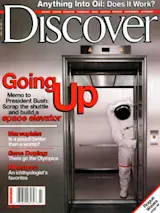Enterprise Survives Sneak Attack
A space-age relic comes to rest in a sheltered roost after a relentless assault by winged marauders.
By Brad Lemley
Steven F. Udvar-Hazy Center
14390 Air and Space Museum Parkway, Chantilly, Va.
Courtesy of Dane Penland/Smithsonian Institution
The 150,000-pound shuttle Enterprise never made it into orbit, but it did fly in tests on top of a 747 jumbo jet. It now stands silently in the Smithsonian's new James S. McDonnell space hangar in Chantilly, Virginia.
The space shuttle Enterprise is among the most advanced flying machines ever built, but it was no match for the woodpeckers. “You can see where they’ve pecked all along the tail,” says museum specialist Tony Carp. We are riding in a hydraulic lift some 50 feet above the floor, examining a sprinkling of quarter-size dents in the aft section. They look even worse than the wasps’ nests I just saw in ...














